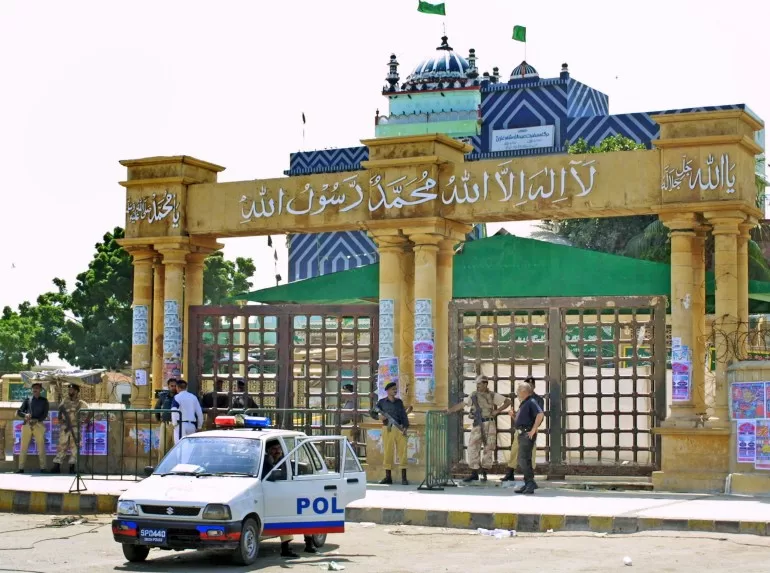Fears of a cyclone loom over Pakistan’s southern city, Karachi, which lies on the country’s Arabian Sea coast.
The city saw school closures and weather advisories on Friday after a night of sporadic rainfall.
Yet, amid worries over the impending storm, Karachi has history on its side – many tropical cyclones that were expected to hit the city eventually skipped it. And devotees of the city’s patron saint Abdullah Shah Ghazi, whose shrine is in Karachi, believe it is Ghazi, and a cyclone-related legacy, which protect Karachi.
Here is more about Asna, the legend of Ghazi and what the science says about why Karachi really tends to avoid being hit by cyclones.
What is Cyclone Asna?
A tropical cyclone could develop and hit Pakistan, authorities warn. If it does, it will be named Asna. A deep depression, which is a very strong low-pressure area, over the Rann of Kutch in India’s Gujarat has slowly moved towards Pakistan.
As of Friday, it is 200km (124 miles) from Karachi, according to a warning issued by the Pakistan Meteorological Department. This depression is expected to turn into a cyclonic storm due to favourable weather conditions, the warning added.
Some areas of Karachi received 147mm (5.79 inches) of rain overnight on Thursday, a local weather office reported. “I would urge the residents of Karachi especially bike riders to avoid unnecessary movement,” Karachi’s mayor, Murtaza Wahab, wrote in an X post on Thursday evening.
It’s been raining since last 3 days & in the next few hours, it is expected that there will be heavier rainfall with strong winds. I would urge the residents of Karachi especially bike riders to avoid unnecessary movement. Stay safe everyone & in case of any emergency call 1339
— Murtaza Wahab Siddiqui (@murtazawahab1) August 29, 2024
Pakistani newspaper Dawn quoted Chief Meteorologist Sardar Sarfaraz as saying that if the cyclonic storm materialised, it would be the first in the Arabian Sea in August since 1976.
What is the legend of Abdullah Shah Ghazi?
Ghazi was a Sufi Muslim saint who lived in the eighth century.
Historical accounts vary, but most agree that Ghazi was Arab, and came to settle in the Sindh province – where Karachi is – with his brother, Syed Misri Shah. Many believe he was born in Saudi Arabia’s Medina, while some accounts suggest he came from Iraq.
It is believed that he was ambushed in the forests in interior Sindh and killed by his enemies. A band of his supporters buried him on a sandy hill, which is located in the seaside Karachi locality of Clifton.

After years of renovations, his shrine has become an architectural and spiritual attraction, drawing devotees from all over the country who travel to the south of Pakistan just to seek Ghazi’s blessings.

Legend has it that back in the day, a group of fishermen in a fishing village were trapped in a cyclone. Ghazi took his eating bowl and filled it with water, stopping the cyclone.
Now, thousands of devotees seek his miracles whenever a cyclone is to hit the city, firmly believing his presence will divert the cyclone from the city.
Many tropical cyclones over the Arabian Sea, including Phet in 2010, Nilofar in 2014, Tauktae in 2021 and Biparjoy in 2023 changed course instead of making landfall in Karachi.
Have cyclones hit Karachi before?
Cyclones have weakened by the time they reach Karachi and have not made landfall.
However, there are other ways they have affected the city, Afia Salam, an environmental journalist from Pakistan, told Al Jazeera. Salam has a master’s degree in geography from the University of Karachi.
A possible topographic explanation for cyclones not making landfall in the city could be that “Karachi is sort of curved inwards”, Salam said. However, she added, “Karachi has been impacted by different aspects of these different cyclones”.
For example, in 2021, while Tauktae did not make landfall in Karachi, dust storms and torrential rains raged in the city. Local media reported that five people, including a woman and two children, died in roof and wall collapse incidents due to the rains and winds.
“Severity has different scales to measure,” Salam said. “Fatalities is one, physical damage is another.”
She explained that Karachi, with a population of nearly 15 million people, is full of “unsafe structures like huge wobbly billboards and dilapidated buildings”. In such a city, a storm that causes infrastructural damage could be more damaging than otherwise forecast by meteorologists.
What does the science say about why Karachi hasn’t been hit by cyclones?
While some believe in miracles, scientists have a different explanation for the fact that Karachi has avoided being hit by cyclones so far.
Fahad Saeed, a climate scientist at the think tank, Climate Analytics, said: “The biggest reason is that in the Arabian Sea, there are generally calm waters. It means that the conditions over the region are not appropriate for the development of a deep cyclone in the month of August”.
Storms heading towards Karachi tend to die out at the “depression” stage – before they form into cyclones – he explained. “Depressions are normally shallow, but when they get deep, which means that they go above the sea level up to a height of a few kilometres, they get more energy and develop into cyclones”.
He added that easterly winds in the middle to upper atmosphere, which are common in this part of the Arabian Sea during monsoon season, also result in conditions unfavourable for the development of cyclones.
“During this time of the year, we have strong easterlies in the upper atmosphere. These are the winds coming from east to west in the middle to upper atmosphere pass over the region of the Arabian Sea and discourage the formation of cyclones or the conversion of depressions into cyclones.
“Historically only three cyclones have developed in the Arabian Sea region in August, but they either moved westward because of these easterlies or died out before making a strong landfall”.
